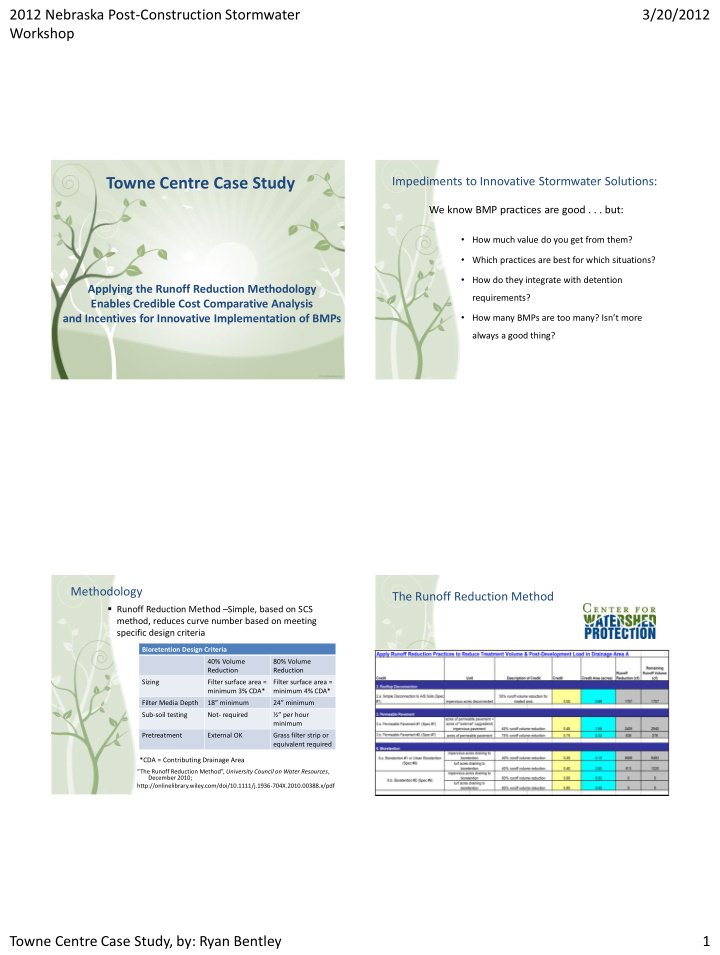



2012 Nebraska Post-Construction Stormwater 3/20/2012 Workshop Towne Centre Case Study Impediments to Innovative Stormwater Solutions: We know BMP practices are good . . . but: • How much value do you get from them? • Which practices are best for which situations? • How do they integrate with detention Applying the Runoff Reduction Methodology requirements? Enables Credible Cost Comparative Analysis and Incentives for Innovative Implementation of BMPs • How many BMPs are too many? Isn’t more always a good thing? Methodology The Runoff Reduction Method Runoff Reduction Method – Simple, based on SCS method, reduces curve number based on meeting specific design criteria Bioretention Design Criteria 40% Volume 80% Volume Reduction Reduction Sizing Filter surface area = Filter surface area = minimum 3% CDA* minimum 4% CDA* Filter Media Depth 18” minimum 24” minimum Sub-soil testing Not- required ½” per hour minimum Pretreatment External OK Grass filter strip or equivalent required *CDA = Contributing Drainage Area “The Runoff Reduction Method”, University Council on Water Resources , December 2010; http://onlinelibrary.wiley.com/doi/10.1111/j.1936-704X.2010.00388.x/pdf Towne Centre Case Study, by: Ryan Bentley 1
2012 Nebraska Post-Construction Stormwater 3/20/2012 Workshop Towne Centre Case Study The Runoff Reduction Method • Planned commercial development with 35 individual buildings and 80 total units • First phase built in 2007 • Site is located in Snellville, Georgia Towne Centre Case Study Towne Centre Case Study – South East U.S. • Long rectangular shape required long large pipes • End-of-the-pipe solution required a large extended dry detention pond with a freestanding wall • Natural gravelly sandy loam soils • Regulations require large tree islands Towne Centre Case Study, by: Ryan Bentley 2
2012 Nebraska Post-Construction Stormwater 3/20/2012 Workshop Towne Centre Case Study – Vicinity Map Towne Centre Case Study – Location Map Towne Centre Case Study – Towne Centre Case Study – Existing Design Layout & Grades Existing Stormwater Layout Required Water Quality Volume: 27,628 CF Required Channel Protection Volume: 82,497 CF 100 Year Storm Volume: 21,449 CF Total CF Pond Storage Provided: 131,574 CF Towne Centre Case Study, by: Ryan Bentley 3
2012 Nebraska Post-Construction Stormwater 3/20/2012 Workshop Towne Centre Case Study- Towne Centre Case Study – Existing Design Developed Drainage Areas Four Alternatives • Bioretention Alternate - Bioretention only • Porous Alternate - Porous pavement only • Soil Alternate - Soil amendments only • Multiple Alternate - Bioretention, porous pavement, soil amendments & chamber system Towne Centre Case Study – Towne Centre Case Study – Bio. Alt. Stormwater Layout Porous Alt. Stormwater Layout Required Water Quality Volume: 10,722 CF Required Water Quality Volume: 6,340 CF Required Channel Protection Volume: 74,172 CF Required Channel Protection Volume: 62,903 CF 100 Year Storm Volume: 19,564 CF 100 Year Storm Volume: 22,121 CF Total CF Pond Storage Provided: 104,440 CF Total CF Pond Storage Provided: 91,364 CF Towne Centre Case Study, by: Ryan Bentley 4
2012 Nebraska Post-Construction Stormwater 3/20/2012 Workshop Towne Centre Case Study – Towne Centre Case Study – Soil Alt. Stormwater Layout Multiple Alt. Stormwater Layout Required Water Quality Volume: 23,718 CF Required Water Quality Volume: 3,460 CF Required Channel Protection Volume: 66,749 CF Required Channel Protection Volume: 56,614 CF 100 Year Storm Volume: 24,053 CF 100 Year Storm Volume: 16,072 CF Total CF Pond Storage Provided: 114,520 CF Total CF Pond Storage Provided: 76,146 CF Towne Centre Case Study – Towne Centre Case Study – Side-by-side Volumes Side-by-side Costs Towne Centre Case Study, by: Ryan Bentley 5
2012 Nebraska Post-Construction Stormwater 3/20/2012 Workshop Towne Centre Case Study – Answers to Innovative Stormwater Solutions: Possible Extra lot • How much value do you get from them? • Which practices are best for which situations? • How do they integrate with detention requirements? • How many BMPs are too many? Isn’t more always a good thing? • To achieve more innovative stormwater Existing Layout solutions we need to: • Credit BMPs for their full contribution to water quality & quantity • Perform comparative analysis for promising sites and situations • Enact flexible stormwater regulations with Bioretention and Multiple Alternate Layout higher water quality and quantity standards Conclusions from this case study? • For appropriate sites, the initial cost of BMPs can be the same or lower cost as traditional stormwater practices. This does not take into account the added landscape value of the site. • The creative opportunity for stormwater designers is huge. • Bioretention is not always the best or most cost effective BMP. • BMPs make noteworthy contributions to water quantity . • Regulations can significantly affect the motivation for innovative design. Towne Centre Case Study, by: Ryan Bentley 6
Recommend
More recommend